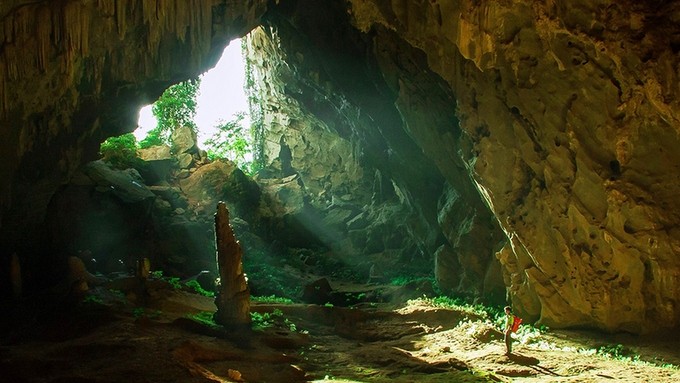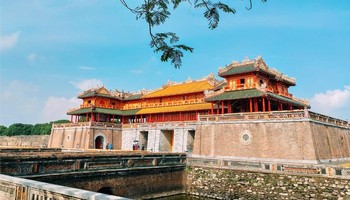As soon as the epidemic was basically under control, the central localities began to make efforts to find a way to recover the tourism activities, creating a motivation for other economic sectors.
According to Director of Da Nang Department of Tourism Truong Thi Hong Hanh, with many localities (such as Quang Binh, Thua Thien Hue, Da Nang, Quang Nam, Khanh Hoa and Lam Dong) where tourism was identified as an economic sector, the damages caused by the pandemic are extremely heavy. By mid-October 2021, over 90% of tourism businesses in the central region had suspended their operations, more than 150,000 direct workers in the tourism industry and millions of related indirect workers were underemployed. The service and tourism industries recorded continuous declines in growth rates as important indicators such as the number of tourists, revenue, promotion plans and the development of new products have been witnessing negative growth. As a result, the businesses had to reduce the number of employees. Many skilled workers also found new jobs, causing a serious decrease in both quantity and quality of human resources. The facilities of accommodation establishments and tourist attractions have seriously degraded due to not being used for a long time.
Since late September 2021, when several provinces and cities began to control the epidemic with rapid decline of the infections, they actively find a way to restore the economy. In particular, the localities have been focusing on implementing plans to receive and serve domestic tourists to step by step recover tourism and promote other sectors including transport, industry and trade and real estate to contribute to the budget revenue along with solving problems related to jobs. In addition, the recovery will help limit the risk of losing the opportunity to exploit the international tourist market compared to destinations in the world that began to reopen for welcoming visitors.
The Da Nang’s authorities held a “dialogue with enterprises”, giving priority to discussing the reopening of air routes, trains and roads. Vice Chairman of the City People’s Committee Tran Phuoc Son said Da Nang plays a key role in the Central and Central Highland regions and is one of the tourism centres of the country. Therefore, the reopening and resumption of tourism activities is necessary as the pandemic is under control. In addition to Da Nang, other provinces such as Quang Binh, Thua Thien Hue, Quang Nam, Khanh Hoa and Lam Dong have developed plans to receive both domestic and international visitors in the new normal.
Chairman of Quang Nam Provincial People's Committee, Le Tri Thanh, noted that the province has controlled the epidemic well and the local accommodation establishments, travel and transportation agencies have also gained experience in welcoming imported Vietnamese guests to ensure the epidemic prevention and control. The Provincial People’s Committee has submitted a proposal to the Prime Minister for his allowance for Quang Nam to welcome international tourists following Phu Quoc.
Da Nang City along with the provinces of Quang Nam, Thua Thien Hue, Khanh Hoa and Lam Dong have coordinated to make plans for receiving international tourists as soon as the Government allows the opening of international air routes. In the immediate future, the reception of domestic tourists will be divided into three phases. Accordingly, the local tourists and official guests will be served from late October; meanwhile, the province will carry out the “tourism bubble” model with some provinces and cities in the central and central highland regions and the localities that have effectively controlled the epidemic, towards exchanging and exploiting sources of visitors. Under this model, the visitors will travel in closed tours that are conducted by travel companies to limit contact.
.jpg) |
Domestic tourists visiting the relic sites in the ancient capital of Hue. (Photo: CONG HAU)
According to Standing Vice Chairman of Khanh Hoa Provincial People's Committee, Le Huu Hoang, the local leaders have submitted to the Government for its approval of a pilot plan to welcome international tourists with "vaccine passports" by charter flights; adding Khanh Hoa to the list of localities permitted to pilot the extension of night time activities to 6am the following day; and supporting the province in opening flights to potential tourism markets when the epidemic is under control. International guests will be taken to Northern Cam Ranh Peninsula Tourist Area and accommodation sites on the islands of Nha Trang. Khan Hoa also expects that the reception of international visitors will be resumed by the end of 2021, focusing on potential markets with high safety in COVID-19 prevention and control, especially Russia.
Meanwhile, Director of Lam Dong Provincial Department of Culture, Sports and Tourism, Nguyen Viet Van, said the province aims to ensure the dual goal of preventing and controlling the epidemic while enhancing socio-economic development, including tourism recovery. In the immediate future, priority will be given to welcoming domestic tourists in localities where the epidemic is well under control. The provincial leaders have allowed the reopening of accommodation, entertainment and beauty services with strict requirements.
Nguyen Chau My, a representative from Oxalis Company, emphasised the necessity of a “green corridor” among the destinations in the localities and tourist attractions in several provinces and cities that have controlled the epidemic. In addition, the central ministries and agencies should issue guides on safe travelling in a new normal and approving closed and safe tours. Since early October, Oxalis has developed closed tours to the Tu Lan cave system in Phong Nha – Ke Bang National Park and submitted them to Quang Binh Provincial People’s Committee. These 2-3-day tours will consist of 8-12 guests. Service staff have been vaccinated and will be tested before the tours.
Chairman of the Da Nang Tourism Association, Cao Tri Dung, affirmed that the tourism businesses in the central and central highland regions are ready for the reopening. The accommodation and service establishments have been reparing and upgrading while developing the scenarios and plans to adapt to the epidemic according to the levels prescribed by the Government. When the epidemic is controlled, the traveling demand of people is very high. Eco-tourism destinations are always chosen to avoid crowds and relax with natural scenery following many days of social distancing. This is the strength of the central and central highland regions. The policy of resuming the reception of tourists is an essential work this time to restore the economy. However, in order to ensure the safety for visitors and local people, the provinces and cities in the regions should give priority to vaccination for staff and workers and the locals in key tourist areas. The coverage of vaccines and the implementation of 5K principles are expected to help visitors be less afraid of exploring famous destinations in the regions.
















